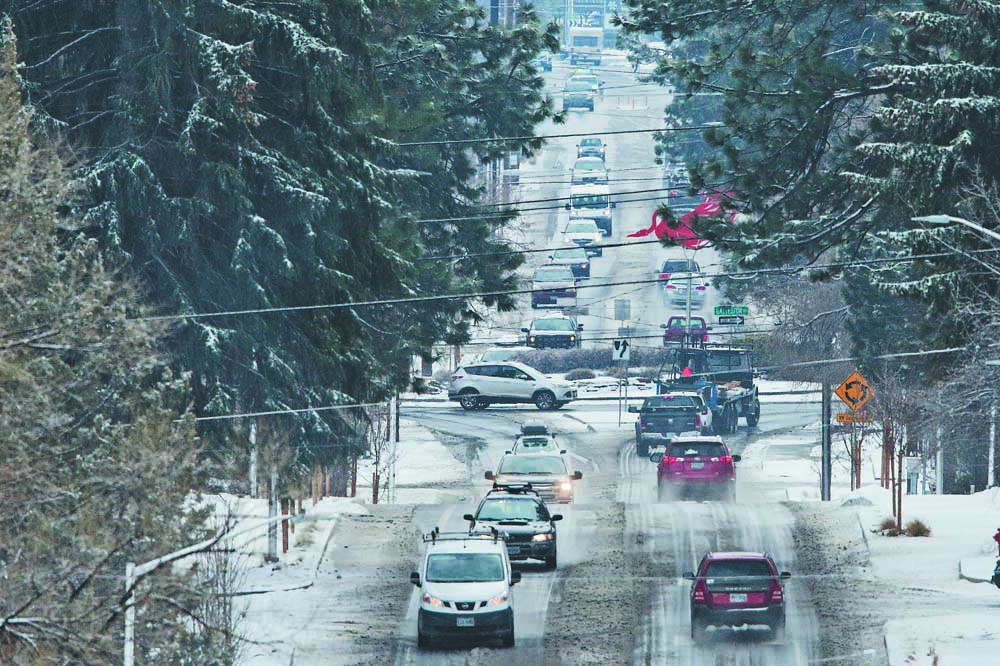Bend mulls alternative ways to measure traffic congestion
Published 12:00 am Saturday, February 16, 2019

- A steady flow of traffic moves down a section of 14th Street in Bend on Thursday, Feb. 14, 2019. (Ryan Brennecke/Bulletin photo)
Try to drive east on Reed Market Road at the wrong time of day, and you may find yourself stuck at a stand-still or in a line of cars creeping toward a roundabout.
By 2040, traffic on the road is expected to exceed its capacity by so much that trips on Reed Market could take 15 minutes longer during busy periods than they would in normal conditions, according to city projections.
Traffic on other roads throughout Bend is expected to increase, and in response, city staff, consultants and members of a city committee are debating whether Bend needs to change how it calculates how much congestion is too much.
“It will get more congested,” Bend Senior Planner Karen Swirsky said during a meeting earlier this month. “There’s no way to keep it from becoming more congested.”
One thing the city’s transportation advisory committee should think about is where in the city congestion is tolerable and where it isn’t, Swirsky said. For instance, congested roads are expected and, to an extent, welcomed in downtown Bend.
“The purpose of downtown streets is to be congested and busy,” said committee member Dale Van Valkenburg, director of planning and land use for Brooks Resources.
A decades-old city policy also prohibits widening sections of several west-side streets, including 14th Street, Newport Avenue and Galveston Avenue. That policy was based on feedback from people who lived in the area and said they would accept more roadway congestion in exchange for preserving their walkable neighborhoods.
The west-side congestion policy came into play late last year, when city officials agreed to a deal with the owners of 412 acres in Bend’s urban growth boundary, which will eventually add about 1,200 new homes.
Fully building out the area will create additional congestion on 14th Street, Newport Avenue and Galveston Avenue, but the developers paid a combined $1.4 million toward reconstructing NW 14th Street last summer instead of widening the other affected streets or adding additional lanes to roundabouts.
City code mandates that developers who want to build new projects evaluate how their developments will affect traffic. Those analyses include looking at whether new car trips caused by the development will prolong waits at all-way stop intersections by 80 seconds or more during highest-traffic hours and whether traffic can back up to the point that it blocks other traffic signals, roundabouts or railroad crossings.
If completing the project means there will be too many new cars for the street system to handle, those developers must mitigate the infrastructure issues by making street improvements or paying the city to make them.
Builders negotiate the improvements they have to make with the city, and this process can have some other negative effects, Swirsky said. For one thing, the city’s traffic standards can make it harder to redevelop areas like the Bend Central District, she said.
“It encourages people to build in parts of town that are less congested,” Swirsky said.
By 2040, city planners predict parts of Reed Market Road, Colorado Avenue, Newport Avenue, Greenwood Avenue and Riverside Boulevard, among others, will fail to meet current traffic standards even with planned improvements.
Once those roads fail, there could effectively be a moratorium on new construction in many parts of Bend. That was an issue faced by the city of Bellingham, Washington nearly two decades ago, Bend planners said.
Bellingham chose to change how it approached congestion by prioritizing connectivity over widening streets and stating in its transportation policies that congestion was to be expected in urban and commercial areas.
If Bend were to adapt a similar model, it could impose higher congestion standards for development in greenfield areas in southeast Bend than it does for redevelopment in the core of the city, Swirsky said.
She and Van Valkenburg said policies that allow more congestion in parts of Bend could also encourage more people to use bikes, buses and other alternatives to cars.
“It’s so easy to drive my car to work that I do, even though it would take me about as long to ride my bike,” Van Valkenburg said.
Committee member Karna Gustafson warned against embracing too much congestion. Gustafson, vice president of government affairs at the Central Oregon Builders Association, said emergency responders are supposed to get to their destinations within six minutes. Bend Fire’s average response time now is 5 minutes, 51 seconds.
“I could say ‘Yeah, it’s great to have congestion so people can ride the bus,’ but if that means somebody dies, I’m not OK with that,” Gustafson said.
Traffic was also the main concern cited by Bend residents who responded to a city-sponsored phone survey and an online survey sponsored by the Bend Chamber of Commerce, Gustafson said.
“If you’re going to get anything done and not end up with a recall of City Council, you need to do something about congestion,” Gustafson said.
— Reporter: 541-633-2160; jshumway@bendbulletin.com






